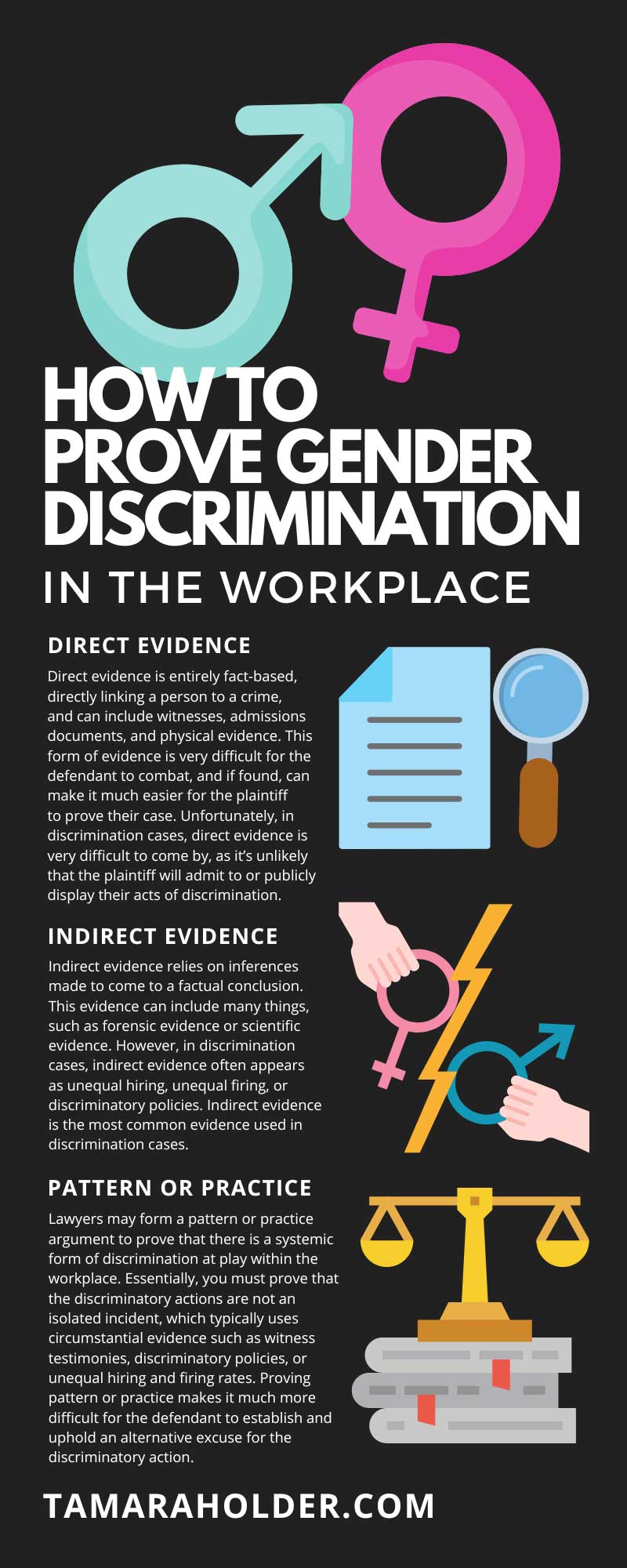How To Prove Gender Discrimination in the Workplace

When we go to work, whether we clock in online or go in person, we expect our employers to treat us with professionalism, respect, and equality. Unfortunately, even in our modern age, this isn’t always the case, and employers may treat their employees in unfair ways based on outdated beliefs and biases. Shockingly, in the fiscal year of 2021, over 18,000 sex discrimination charges were filed with the EEOC. Such charges made up more than 30 percent of that year’s cases—consistent with percentages since 1997.
This isn’t to say every charge claimants filed went in favor of the victim, as employment and discrimination laws are both very complex. Cases can be difficult to prove without the right knowledge, which means that learning how to prove gender discrimination in the workplace is critical to receiving justice.
What Gender Discrimination Is
Before we can discuss what is necessary to prove gender discrimination, we must first understand what it is. Gender and sex are two different things, both scientifically and in terms of the law. You may hear sex discrimination and gender discrimination used interchangeably, but they are not the same thing. Sex-based discrimination is an umbrella term that encompasses discrimination against sexual orientation, pregnancy status, and gender identity.
For the purposes of this article, we will discuss gender discrimination as it pertains to transgender and cisgender individuals. Keep in mind that you can experience gender discrimination based on the gender someone sees you as and not necessarily how you identify.
Understanding Different Types of Evidence
When it comes to domination cases, courts will accept two types of evidence: direct and indirect. When attempting to prove your case, as we will discuss, you can use either form of evidence to prove your points. You can also use these forms of evidence to prove a pattern or practice.
Direct Evidence
Direct evidence is entirely fact-based, directly linking a person to a crime, and can include witnesses, admissions documents, and physical evidence. This form of evidence is very difficult for the defendant to combat, and if found, can make it much easier for the plaintiff to prove their case. Unfortunately, in discrimination cases, direct evidence is very difficult to come by, as it’s unlikely that the plaintiff will admit to or publicly display their acts of discrimination.
Indirect Evidence
Indirect evidence relies on inferences made to come to a factual conclusion. This evidence can include many things, such as forensic evidence or scientific evidence. However, in discrimination cases, indirect evidence often appears as unequal hiring, unequal firing, or discriminatory policies. Indirect evidence is the most common evidence used in discrimination cases.
Pattern or Practice
Lawyers may form a pattern or practice argument to prove that there is a systemic form of discrimination at play within the workplace. Essentially, you must prove that the discriminatory actions are not an isolated incident, which typically uses circumstantial evidence such as witness testimonies, discriminatory policies, or unequal hiring and firing rates. Proving pattern or practice makes it much more difficult for the defendant to establish and uphold an alternative excuse for the discriminatory action.
Establishing a Prima Facie Case
To prove that gender discrimination occurred in the workplace, you must first establish a prima facie case of discrimination. This translates to “at first sight” and is used in law to establish whether a case should proceed to trial. To establish a prima facie case for discrimination, the plaintiff must prove the four requirements below.
You’re a Member of a Protected Class
The plaintiff’s first job is to prove that they are a member of a protected class. People belonging to protected classes receive special protections that make discrimination against them illegal. In accordance with Title VII, it is illegal to discriminate against someone based on their sex, sexual orientation, gender, religion, origin, race, color, age, disability, or pregnancy status. For cisgender people, proving this is relatively easy, but for transgender people, proving their gender is a subject of contention. It is incredibly important for transgender individuals to receive legal representation from lawyers that actively support trans people.
You Suffered Adverse Action
Once you prove that you are part of a protected class, you must then prove that you suffered a negative or adverse action. If you believe that your supervisor denied you a promotion, undercompensated you, or wrongfully terminated you, you must prove that this action occurred and it adversely affected you. The impact can be emotional, physical, psychological, or even financial.
You Were Qualified for the Job
Even if you have been in your position for some time, you still have to prove that you were qualified for the job and met expectations. You must show that you met all the requirements stated in your employee contract. If you don’t, then you cannot establish a prima facie discrimination case. For example, if you were supposed to make a certain amount of sales per month and consistently underperformed, you did not meet your role’s requirements. In this situation, your case will not go to trial.
Others Were Treated Fairly
If your employer terminated you, demoted you, or denied you benefits, you must prove that others experienced dissimilar treatment despite meeting the same requirements as you. For example, if the employer fires a trans woman and replaces her with a cisgender man with the same qualifications, she can further prove discrimination.
What Happens Next?
Once you establish a prima facie case of discretion, the burden of proof then shifts to the defendant. The defendant will likely state that they had an alternative reason for taking the adverse action. For instance, they could claim that it was because of consistent tardiness, inappropriate workplace behavior, or underperformance. The burden of proof then switches back to the plaintiff, who must demonstrate pretext. Essentially, the plaintiff will call into question the validity and logic behind the defendant’s reason, and if the court finds the reason invalid, the burden of proof shifts back. This back and forth can go on for quite some time.
If you believe that you’ve been a victim of gender discrimination, you’re not alone—there are people that care and are willing to give you the legal representation you need. Gender discrimination lawyer Tamara Holder is dedicated to getting justice for victims and will use her years of knowledge to get you the compensation you deserve.


